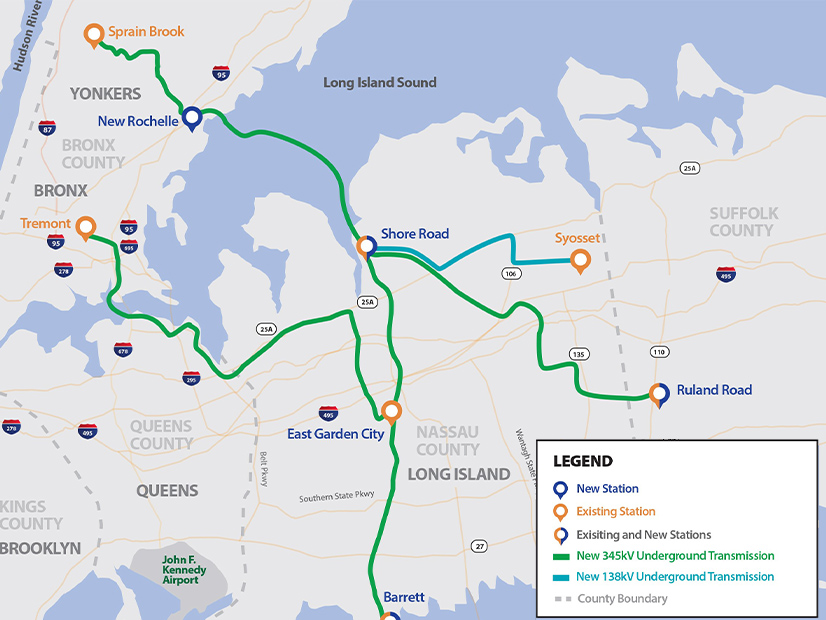ALBANY, N.Y. — NYISO on Tuesday announced its Board of Directions selected a proposal from Propel NY Energy to fulfill the Long Island Public Policy Transmission Needs (PPTN) solicitation to unbottle local constraints and enable the export of future offshore wind energy throughout New York.
Propel NY, a partnership between the New York Power Authority and NY Transco, will build its Alternative Solution 5 project with the Long Island Power Authority and Consolidated Edison, with the goal of “advancing the state closer to its goal of 9,000 MW of offshore wind energy by 2035,” the board said.
NYISO estimated that the project will cost $3.26 billion. The developers will build a network of new transmission lines and substations connecting Long Island to New York City and estimate they will break ground in 2026. It has a required in-service date of May 2030.
Propel NY’s project (Project ID: T051) emerged as NYISO’s preference in early May and quickly obtained stakeholder votes of recommendation for approval before moving forward to the board for approval. (See “Long Island PPTN,” NYISO TPAS Briefs: June 16, 2023.)
In an interview with RTO Insider, Philip Toia, president of development at NYPA, and Paul Haering, vice president of capital investment at New York Transco, shared how excited they are to help deliver clean energy throughout New York and bring the state closer to its decarbonization goals.
Propel NY’s project “reinforces the backbone of the transmission system in Long Island,” Toia said.
It “checks a number of boxes that the NYISO evaluates, including transfer capability, expandability and operability,” said Haering.
The project will build six new underground transmission lines, including five 345-kV lines, that go between three ties connecting Long Island to the New York City metropolitan area and four new substations. It also upgrades several LIPA-operated facilities.
Haering said, “The goal of the PPTN was to improve the transfer capabilities between Long Island and New York City,” and the Alternative Solution 5 “proposal is going to greatly increase that capability” by enabling “offshore wind to get upstate” while “improving the ability for energy from upstate to get back onto Long Island when the wind isn’t blowing.”
Toia said there could be a few challenges, including unclogging an already a congested Long Island transmission system, getting community stakeholders involved via consistent outreach and permitting processes.
Haering noted ongoing supply chain disruptions also could be problematic should key components like high-voltage cables become unavailable. He added that their teams have worked aggressively to ensure that all the manpower, resources and equipment are available to execute the project.
Transmission projects in general, particularly those in crowded regions such as New York City and its eastern suburbs on Long Island, can draw opposition and pushback. Propel NY is taking an “early, often and inclusive” stakeholder approach to build support and head off opposition, Haering said.
Shannon Baxevanis, communications and stakeholder lead at NY Transco, said, “For the last two years, we’ve been undertaking an education and awareness effort with stakeholders that are within the [project’s] geographic footprint.”
Baxevanis said these have mostly been high-level conversations with politicians, economic development organizations, and environment or advocacy groups, but “that will really morph into a more developed granular ground game.”
“We are going street-by-street, neighborhood-by-neighborhood, getting to know residents, making them aware of what the project is and giving them the conduit to have a voice in our process,” she added.
Haering applauded the PPTN process, saying, “It is the poster child for how it should be done.”
Toia added, “We have confidence in the [PPTN’s] open process,” and, “when you look at New York, there’s a multitude of pathways for transmission to be built. … It’s an all-hands-on deck approach that has been successful for the state.”
RTO Insider asked about renewable and offshore wind development more broadly and whether New York could achieve its ambitious decarbonization goals.
Toia admitted the goals are aggressive but was confident that they could be reached via effective transmission development.
“Transmission is key to ensuring that renewable energy that is being built is able to get to the market and is not bottlenecked anywhere,” he said.
Haering pointed out that “because of our knowledge of the system, it was recognized by NYISO and its independent consultant that our project had some of the least amount of risk as compared to some of the other proposals,” and so, “hopefully that means this project will be delivered on time and on budget for the benefit of ratepayers.”
Haering said they anticipate filing relevant Article VII paperwork, which is the application material required for major New York transmission facilities, with the state’s Public Service Commission in the first half of 2024.


